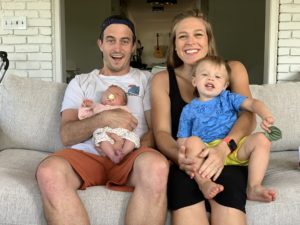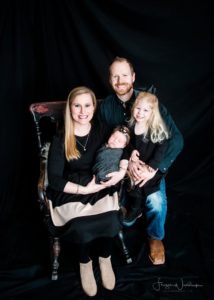Pregnancy in a Pandemic
Learning that there’s a baby on the way is life changing for any new parent-to-be. But a positive pregnancy test during a pandemic when a woman is a clinician required a whole new level of self-care – and courage.
In the Saint Francis Health System, Dr. Ryan Parker gave kudos to six women on her team who became mothers – several for the first time – during the height of COVID-19: Dr. Dana Pentecost, Dr. Amanda Savage, Dr. Jordan Wolfe, PA-C Martha Owen, PA-C Ashley Bemo and NP Brice Harader-Pate.
“It has been hard enough to practice during the pandemic, but these ladies maneuvered through overcrowded EDs, night shifts, critical patients and layers of PPE all while incubating another human (and two humans in the case of Ashley Bemo). It reminds me of the quote about Ginger Rogers doing everything that Fred Astaire did ‘backwards and in high heels,’ “ Dr. Parker said. “Special shout out to Dr. Wolfe who went into labor during her shift, finished the last few hours and then went upstairs to L&D and delivered her baby.”
Supportive Colleagues
PA Ashley Bemo was quick to share gratitude for her colleagues.
“My colleagues did an awesome job of protecting and supporting me,” she said. “I was pregnant at the very beginning of the pandemic and really vigilant about PPE and taking care of myself and my babies. But if there was a particularly sick patient, my colleagues helped cover them. We all watch out for each other! Everything was new at the time – we were trying lots of creative things to figure out the best way to practice in all of the unknown.”
Protecting Baby
“In many ways, it was actually less scary when I was pregnant,” said Bemo. “I could protect them by protecting myself. I felt like I had more control.”
Life certainly became a lot more challenging for NP Brice Haradar-Pate and her wife, Reese, an ED nurse, after their son Owen was no longer safely in utero. The couple had done fertility treatments before COVID was on their radar at all and went into the stressful pandemic with a resolute passion to do their jobs despite the dangers and constantly worrying about each other.
“One of the big pandemic challenges especially after he got into daycare were the days when little ones were exposed. It’s a hospital daycare, so there was a lot of exposure!” Haradar-Pate said. “We have no family where we live, so we often had to rely on friends at the last minute to help us. Also, just the knowledge that we couldn’t protect him 100% – too young for vaccinations and you can’t have a baby wear a mask.”
Dr. Amanda Savage also was incredibly careful with what her brand new son, James, was exposed to. “We didn’t set foot into a store or really take him anywhere: people are so sick, and he’s so little.”
Family Time
Dr. Savage moved to Oklahoma only in August from Michigan and was drawn to US Acute Care Solutions in part for its generous family leave policy.
“When I met with the team here, I was really excited to be a part of it all, and I’m so glad I am,” she said. “Ryan Parker is an amazing boss, and I feel like administration is very supportive.”
If not now, when?
For Dr. Savage, the decision of timing was a factor in when to become a mom.
“We originally hoped to get pregnant in 2020, but it was just so scary then, and wen the vaccine came out, it was a game changer, and we had more knowledge about the virus,” she said. “There’s no perfect time to do something – nothing will ever completely align. I actually got Covid in December, but I was vaccinated and boosted, so for me it was just two days of cold-like symptoms and everything was fine.”
Embracing Wellness
Throughout her pregnancy, Dr. Savage felt she benefitted by placing special emphasis on embracing wellness.
“Typically, the pace is all ‘go, go, go’ but I made myself slow down, eat, drink water, and just take a moment when I needed to,” she said. “Not just for myself, but for the life I was nourishing.”
PA-C Martha Owen gave birth to a son, Finn, in March of 2020, and is now approximately six months pregnant. She did everything possible to protect her baby.
“My child and I didn’t leave the house other than doctor’s appointments for about the first month of his life and he didn’t go anywhere other than grandparents’ house until about 3-4 months. I only did grocery pickup or delivery for several months. No one (other than grandparents) was allowed to meet him or hold him for several months,” said Owen. “I didn’t have outside childcare until he was a year old. My father-in-law (who also works in the ER) went back to work about a week after he was born so my mother-in-law didn’t see her grandchild for about a month out of precaution since my father-in-law was going into work.”
Owen now feels much safer with vaccinations in place. She also felt greatly cared for by her USACS community.
“All of my colleagues have been so supportive through both pregnancy and newborn life,” she said. “Many dropped off diapers, wipes and other essentials on my doorstep at the beginning of the pandemic when I had a tiny newborn. Now, they are always reminding me to eat and take small breaks.”
Tough Mama

Dr. Wolfe is married to a fellow USACS physician, Mike Hunihan, and their daughter’s name, Iona, was inspired from a pre-pandemic trip to Scottland and joins big brother, Wilder. Iona was born last August, after Dr. Wolfe worked a whole shift. Labor started toward the end of her shift.
“I had wondered if that would happen,” she said. “I was induced with my first, so I suspected it might. It actually worked out well to be distracted during the pain of labor – it was a super busy shift and I would time my contractions as I was writing patient notes. Any of our women docs would have done that in the same situation – we had a great team that day, with many understanding moms.”
Pregnancy Before vs. During the Pandemic
For the doctors for whom this is a second child, they couldn’t help but compare the pregnancy before and after the pandemic.
“It was definitely so different,” said Dr. Dana Pentecost. “Our first daughter was born when times were more normal. Our newest was born in February of 2022. The pandemic changed everything – it was a lot of worrying about not knowing how COVID would affect pregnancy – especially with Delta and Omricon – a lot of appointments where my husband couldn’t go to visits with me. A lot of us pandemic moms put off having a child until later – we delayed for about a year until there was a vaccine.”
A Whole New Level of Empathy
Not having a support system in the room became especially impactful two days before Christmas at her 20-week ultrasound, where an abnormality was detected.
“She’s fine now, but it was really scary in those moments, and it really made me feel for my patients who are by themselves and we’re giving them a diagnosis they had no idea about,” she said.
Making the Most of Parental Leave
A positive difference between the two pregnancies was the amount of time Dr. Pentecost got to spend with her baby after giving birth.
“When I had Emma, I was in residency, so I had to make up the days I took off after everyone else had graduated,” she said. “But my OBs were flabbergasted at how much paid time I got to take off after Clara. USACS maternity leave is above and beyond, unheard of in our profession.”
Children of the Pandemic
From the early days of the unknown variables to the current state of COVID, clinicians giving birth during the pandemic took courage and grit. USACS is thrilled to celebrate the new arrivals:
2020
Martha Owen, Finn, in March; new baby coming soon!
Brice Harader Pate – Owen, in August
Ashley Bemo, Harper and Hazel, in September 2020
2021
Dr. Jordan Wolfe & Dr. Mike Hunihan, Iona, in August
2022
Dr. Dana Pentecost, A daughter, in February
Dr. Amanda Savage, James, in February




